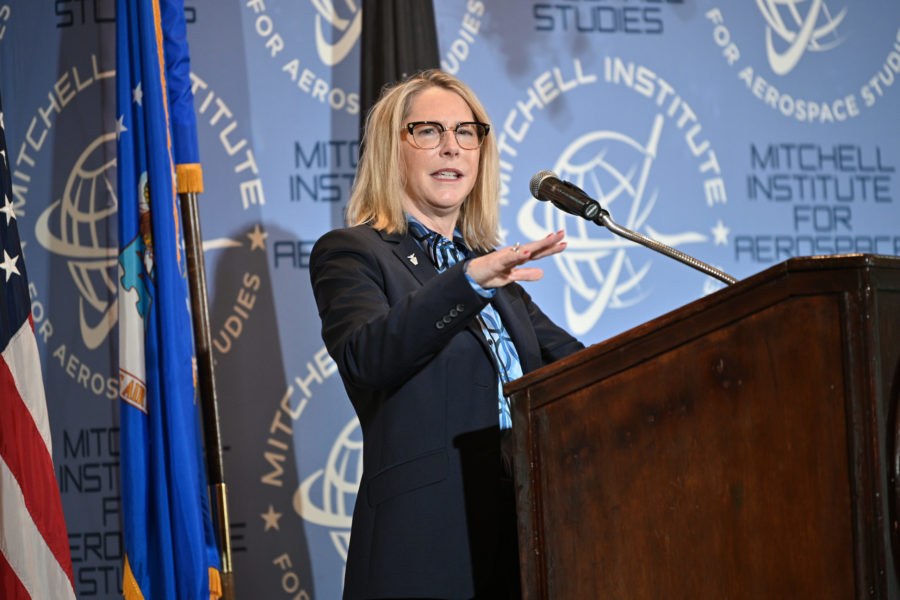While leaders have touted the Space Force as the U.S.’s first digital service, it still faces plenty of technological shortcomings, Chief Information and Technology Officer Lisa Costa said recently. And instead of trying to update all of its outdated IT, the service might be better served by simply starting fresh and building from scratch, she suggested.
Such an approach, referred to as “greenfielding” within the IT community, would be similar to how the Space Development Agency has established its own processes for acquiring and launching satellites, Costa said April 5 at the Mitchell Institute’s Spacepower Security Forum.
“I fundamentally believe that we will get ahead much quicker if we don’t try to dig ourselves out of tech debt, but we just leap over that and move to software-defined everything and modern systems that keep evolving over time,” Costa said when asked about previous comments that the Space Force may need seven years to mature its digital systems. “[SDA director Derek M.] Tournear, that’s exactly what he’s doing, and it’s really a great initiative. And I think that’s the same thing that we need to do in terms of digital infrastructure.”
Starting fresh instead of building on what has been used “would make monetary sense, return-on-investment sense,” Costa added, before noting that doing so would run counter to the Pentagon’s typical style of doing business.
As things currently stand, Costa outlined three priorities her office is pursuing to upgrade the Space Force’s digital infrastructure.
ION
While much of the Space Force’s first few years have been defined by establishing organizational structures and connections, the service now needs to focus on ensuring those structures can integrate digitally, Costa said.
“So we have Space Systems Command, right?” said Costa. “We need to help them connect in a high bandwidth … low latency way to, for example, the Space Warfighting Analysis Center. We need to be able to link them to Space Training and Readiness Command, so that they can provide model-based systems engineering models to STARCOM so that training materials can be developed for Guardians, and so that they can then take that training material and have Guardians developing tactics, techniques, and procedures and conceps of operation. And then that gets translated to [Space Operations Command]. So we’re not only doing the vertical, physical piece but also the functional integration piece.”
That high-bandwidth, low-latency connection will be the Integrated Operations Network, the base IT infrastructure on which the service’s digital efforts will rely. ION will be crucial, Costa noted, especially given the Pentagon’s notoriously slow networks.
“I can’t emphasize enough—I could implement [artificial intelligence] today,” Costa said. “But I couldn’t even read an MPEG-4 file on my desktop that someone sent me last week. So exactly how are we going to be running AI and deep learning algorithms without enabling the entire force to be able to do this instead of just small enclaves being able to do it?”
Costa later compared ION to “the foundation and all the plumbing that has to be done” while building a house.
“That’s kind of the dirty work, and no one really wants to get involved in that,” she said.
An operational planning team to drive ION came together last November, Costa said, and a request for proposals from industry will go out in late April.
Enhanced UDL
For years now, the Space Force has worked to build its Unified Data Library—a single integrated repository of space-related data.
But while Costa praised the UDL as a “great initiative,” she also said that as currently designed, it is insufficient.
“It was never designed to take on the at-scale data needed and being provided by commercial entities,” Costa said. “And so we have built a series of requirements for ‘Enhanced UDL’ and that request for proposals I believe is coming out early in 2024. So the focus of that particular RFP will be on allowing us to have discoverability, accessibility, and at-scale processing.”
The Space Force has requested $56 million for the so-called Enhanced UDL in its 2024 budget, according to news reports.
“Spaceverse”
Perhaps the most ambitious project Costa’s office is pursuing is the “Spaceverse,” a digital environment connecting Guardians from across commands and units and giving them more immersive training and operational experiences.
Often compared to the “metaverse” virtual environment, Spaceverse is a needed asset for Guardians, Costa argued.
“They sit there for 12-hour shifts, and they watch 24 open screens and text messages coming up,” Costa said. “And all of the integration of that information is happening where? It’s happening in their brains. Imagine the exhaustion of walking out of that place after 12 hours. We have got to do this a different way. And one of those ways is meeting our Guardians where they come to us from. Our Guardians have been training for their jobs for their entire lifetime, because they have been gamers.”
Through the Spaceverse, Guardians will be able to interact with space in a way that they simply can’t right now, Costa said—and the service is working alongside other agencies like NASA to further develop the concept.
But while Costa noted the allure of Spaceverse, she also sounded a note of caution.
“We could spend billions of dollars on the concept of Spaceverse, and it wouldn’t run,” Costa said. “None of it would run, because we don’t have the infrastructure to run it on. And that’s why ION is so important.”
